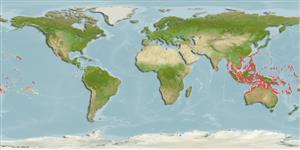>
Eupercaria/misc (Various families in series Eupercaria) >
Labridae (Wrasses) > Corinae
Etymology: Macropharyngodon: Greek, makros = great + Greek, pharyngx = pharynx + Greek,odous = teeth (Ref. 45335).
More on author: Herre.
Environment: milieu / climate zone / depth range / distribution range
Écologie
marin récifal; non migrateur; profondeur 8 - 32 m (Ref. 1602), usually 8 - 32 m (Ref. 27115). Tropical; 24°C - 28°C (Ref. 27115); 30°N - 24°S
Eastern Indian Ocean and Western Pacific: Andaman Sea (Ref. 9710) and Christmas Island (Ref. 30874) to the Philippines and Samoa, north to Ryukyu Islands, south to northern Australia.
Taille / Poids / Âge
Maturity: Lm ? range ? - ? cm
Max length : 12.0 cm TL mâle / non sexé; (Ref. 9710)
Épines dorsales (Total): 9; Rayons mous dorsaux (Total): 11; Épines anales 3; Rayons mous anaux: 11; Vertèbres: 25. Color in life of black with iridescent blue-green spots on body and light yellow antero-dorsally on head body; head banded. Anterior lateral line pored scales 2-3. Males display with metallic green shiny color that is turned on shortly for the occasion (Ref. 48636).
Inhabits lagoon and seaward reefs, in areas of mixed sand and coral (Ref. 9710). Post pelagic juveniles carried by currents beyond their normal breeding range. They are often in pairs or small loose groups, swimming close to the bottom. When approached, they move up and down in an unusual way that may worry a possible predator. Adults move about in small groups. (Ref. 48636).
Life cycle and mating behavior
Maturité | Reproduction | Frai | Œufs | Fécondité | Larves
Oviparous, distinct pairing during breeding (Ref. 205).
Randall, J.E., 1978. A revision of the Indo-Pacific labrid fish genus Macropharyngodon, with descriptions of five new species. Bull. Mar. Sci. 28(4):742-770. (Ref. 2694)
Statut dans la liste rouge de l'IUCN (Ref. 130435)
Menace pour l'homme
Harmless
Utilisations par l'homme
Aquarium: Commercial
Plus d'informations
RéférencesAquacultureProfil d'aquacultureSouchesGénétiqueElectrophoresesHéritabilitéPathologiesTraitementNutrientsMass conversion
CollaborateursImagesStamps, Coins Misc.SonsCiguateraVitesseType de nageSurface branchialeOtolithesCerveauxVision
Outils
Articles particuliers
Télécharger en XML
Sources Internet
Estimates based on models
Preferred temperature (Ref.
123201): 25.2 - 29, mean 28.1 °C (based on 866 cells).
Phylogenetic diversity index (Ref.
82804): PD
50 = 0.5002 [Uniqueness, from 0.5 = low to 2.0 = high].
Bayesian length-weight: a=0.00977 (0.00470 - 0.02030), b=3.07 (2.89 - 3.25), in cm total length, based on LWR estimates for this (Sub)family-body shape (Ref.
93245).
Niveau trophique (Ref.
69278): 3.5 ±0.4 se; based on size and trophs of closest relatives
Résilience (Ref.
120179): Haut, temps minimum de doublement de population inférieur à 15 mois (Preliminary K or Fecundity.).
Fishing Vulnerability (Ref.
59153): Low vulnerability (10 of 100).
Nutrients (Ref.
124155): Calcium = 99.8 [59.3, 177.4] mg/100g; Iron = 0.773 [0.445, 1.445] mg/100g; Protein = 18.5 [15.6, 20.7] %; Omega3 = 0.17 [0.11, 0.28] g/100g; Selenium = 22.8 [13.0, 42.4] μg/100g; VitaminA = 158 [48, 611] μg/100g; Zinc = 1.75 [1.17, 2.72] mg/100g (wet weight);
